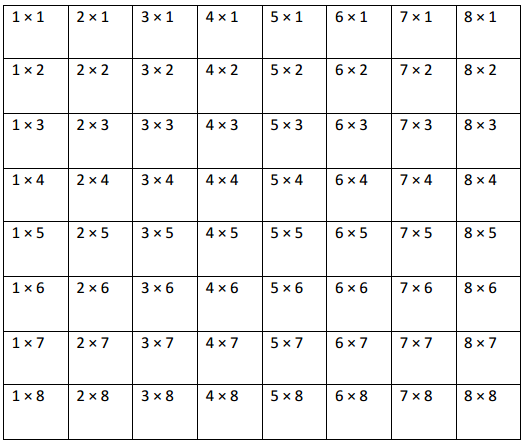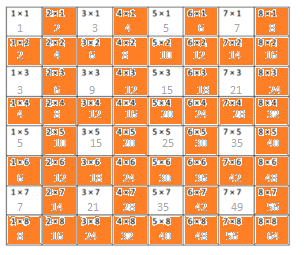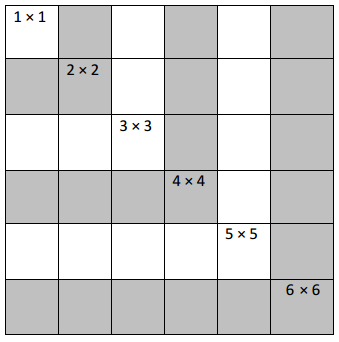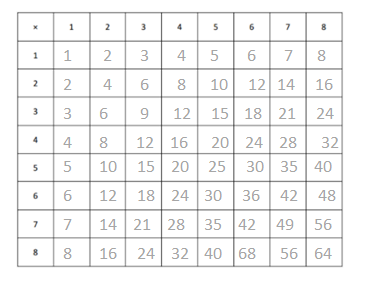Students of Grade 3 can get a strong foundation by referring to the Eureka Math Book. It was developed by highly professional mathematics educators and the solutions prepared by them are in a concise manner for easy grasping. To achieve high scores in Grade 3, students need to solve all questions and exercises included in Eureka Grade 3 Book.
Engage NY Eureka Math 3rd Grade Module 3 Lesson 17 Answer Key
Teachers and students can find this Eureka Book Answer Key for Grade 3 more helpful in raising students’ scores and supporting teachers to educate the students. Learning activities are the best option to educate elementary school kids and make them understand the basic mathematical concepts like addition, subtraction, multiplication, division, etc. Grade 3 elementary school students can find these fun-learning exercises for all math concepts through the Eureka Book.
Eureka Math Grade 3 Module 3 Lesson 17 Problem Set Answer Key
Question 1.
Write the products into the squares as fast as you can.

a. Color all the squares with even products orange. Can an even product ever have an odd factor?
Answer:
1 x 1 = 1, 1 x 2 = 2, 1 x 3 = 3, 1 x 4 = 4, 1 x 5 = 5, 1 x 6 = 6, 1 x 7 = 8, 1 x 8 = 8, 2 x 1 = 2, 2 x 2 = 4, 2 x 3 = 6, 2 x 4 = 8, 2 x 5 = 10, 2 x 6 = 12, 2 x 7 = 14, 2 x 8 = 16, 3 x 1 = 3, 3 x 2 = 6, 3 x 3 = 9, 3 x 4 = 12, 3 x 5 = 15, 3 x 6 = 18, 3 x 7 = 21, 3 x 8 = 24, 4 x 1 = 4, 4 x 2 = 8, 4 x 3 = 12, 4 x 4 = 16, 4 x 5 = 20, 4 x 6 = 24, 4 x 7 = 28, 4 x 8 = 32, 5 x 1 = 5, 5 x 2 = 10, 5 x 3 = 15, 5 x 4 = 20, 5 x 5 = 25, 5 x 6 = 30, 5 x 7 = 35, 5 x 8 = 40, 6 x 1 = 6, 6 x 2 = 12, 6 x 3 = 18, 6 x 4 = 24, 6 x 5 = 30, 6 x 6 = 36, 6 x 7 = 42, 6 x 8 = 48, 7 x 1 = 7, 7 x 2 = 14, 7 x 3 = 21, 7 x 4 = 28, 7 x 5 = 35, 7 x 6 = 42, 7 x 7 = 49, 7 x 8 = 56, 8 x 1 = 8, 8 x 2 = 16, 8 x 3 = 24, 8 x 4 = 32, 8 x 5 = 40, 8 x 6 = 48, 8 x 7 = 56, 8 x 8 = 64.
Explanation:
In the above-given question,
given that,

b. Can an odd product ever have an even factor?
Answer:
No, an odd product ever has an even factor.
Explanation:
In the above-given question,
given that,
1 x 1 = 1, 1 x 2 = 2, 1 x 3 = 3, 1 x 4 = 4, 1 x 5 = 5, 1 x 6 = 6, 1 x 7 = 8, 1 x 8 = 8, 2 x 1 = 2, 2 x 2 = 4, 2 x 3 = 6, 2 x 4 = 8, 2 x 5 = 10, 2 x 6 = 12, 2 x 7 = 14, 2 x 8 = 16, 3 x 1 = 3, 3 x 2 = 6, 3 x 3 = 9, 3 x 4 = 12, 3 x 5 = 15, 3 x 6 = 18, 3 x 7 = 21, 3 x 8 = 24, 4 x 1 = 4, 4 x 2 = 8, 4 x 3 = 12, 4 x 4 = 16, 4 x 5 = 20, 4 x 6 = 24, 4 x 7 = 28, 4 x 8 = 32, 5 x 1 = 5, 5 x 2 = 10, 5 x 3 = 15, 5 x 4 = 20, 5 x 5 = 25, 5 x 6 = 30, 5 x 7 = 35, 5 x 8 = 40, 6 x 1 = 6, 6 x 2 = 12, 6 x 3 = 18, 6 x 4 = 24, 6 x 5 = 30, 6 x 6 = 36, 6 x 7 = 42, 6 x 8 = 48, 7 x 1 = 7, 7 x 2 = 14, 7 x 3 = 21, 7 x 4 = 28, 7 x 5 = 35, 7 x 6 = 42, 7 x 7 = 49, 7 x 8 = 56, 8 x 1 = 8, 8 x 2 = 16, 8 x 3 = 24, 8 x 4 = 32, 8 x 5 = 40, 8 x 6 = 48, 8 x 7 = 56, 8 x 8 = 64.
No, an odd product ever has an even factor.
c. Everyone knows that 7 × 4 = (5 × 4) + (2 × 4). Explain how this is shown in the table.
Answer:
7 x 4 = 28.
5 x 4 = 20.
2 x 4 = 8.
20 + 8 = 28.
Explanation:
In the above-given question,
given that,
7 x 4 = 28.
5 x 4 = 20.
2 x 4 = 8.
20 + 8 = 28.
d. Use what you know to find the product of 7 × 16 or 8 sevens + 8 sevens.
Answer:
7 x 16 = 112.
Explanation:
In the above-given question,
given that,
7 x 6 = 112.
8 sevens + 8 sevens.
8 x 7 + 8 x 7.
56 + 56.
112.
Question 2.
In the table, only the products on the diagonal are shown.

a. Label each product on the diagonal.
Answer:
1 x 2 = 2, 1 x 3 = 3, 1 x 4 = 4, 1 x 5 = 5, 1 x 6 = 6, 2 x 1 = 2, 2 x 3 = 6, 2 x 4 = 8, 2 x 5 = 10, 2 x 6 = 12, 3 x 1 = 3, 3 x 2 = 6, 3 x 4 = 12, 3 x 5 = 15, 3 x 6 = 18, 4 x 1 = 4, 4 x 2 = 8, 4 x 3 = 12, 4 x 5 = 20, 4 x 6 = 24, 5 x 1 = 5, 5 x 2 = 1, 5 x 3 = 15, 5 x 4 = 20, 5 x 6 = 30, 6 x 1 = 6, 6 x 2 = 12, 6 x 3 = 18, 6 x 4 = 24, 6 x 5 = 30.
Explanation:
In the above-given question,
given that,

b. Draw an array to match each expression in the table below. Then, label the number of squares you added to make each new array. The first two arrays have been done for you.
Answer:
1 + 2 = 3.
3 + 6 = 9.
6 + 10 = 16.
10 + 15 = 25.
15 + 21 = 36.
Explanation:
In the above-given question,
given that,
1 + 2 = 3.
3 + 6 = 9.
6 + 10 = 16.
10 + 15 = 25.
15 + 21 = 36.


c. What pattern do you notice in the number of squares that are added to each new array?
Answer:
1 + 3 = 4.
4 + 6 = 9.
6 + 10 = 16.
10 + 15 = 25.
15 + 21 = 36.
Explanation:
In the above-given question,
given that,
1 + 3 = 4.
4 + 6 = 9.
6 + 10 = 16.
10 + 15 = 25.
15 + 21 = 36.
d. Use the pattern you discovered in Part (b) to prove this: 9 × 9 is the sum of the first 9 odd numbers.
Answer:
9 x 9 = 81.
Explanation:
In the above-given question,
given that,
9 x 9 = 81.
the sum of the first 9 odd numbers is 81.
9 x 9 = 81.
Eureka Math Grade 3 Module 3 Lesson 17 Exit Ticket Answer Key
Question 1.
Use what you know to find the product of 8 × 12 or 6 eights + 6 eights.
Answer:
8 x 12 = 96.
Explanation:
In the above-given question,
given that,
8 x 12 = 96.
6 eights + 6 eights.
6 x 8 + 6 x 8.
48 + 48.
96.
Question 2.
Luis says 3 × 233 = 626. Use what you learned about odd times odd to explain why Luis is wrong.
Answer:
3 x 233 = 626.
Explanation:
In the above-given question,
given that,
3 x 233 = 626.
odd x odd = odd.
but in the given question,
Luis is wrong.
3 x 233 = 626.
625 + 1.
Eureka Math Grade 3 Module 3 Lesson 17 Homework Answer Key
Question 1.
a. Write the products into the chart as fast as you can.

Answer:
1 x 1 = 1, 1 x 2 = 2, 1 x 3 = 3, 1 x 4 = 4, 1 x 5 = 5, 1 x 6 = 6, 1 x 7 = 8, 1 x 8 = 8, 2 x 1 = 2, 2 x 2 = 4, 2 x 3 = 6, 2 x 4 = 8, 2 x 5 = 10, 2 x 6 = 12, 2 x 7 = 14, 2 x 8 = 16, 3 x 1 = 3, 3 x 2 = 6, 3 x 3 = 9, 3 x 4 = 12, 3 x 5 = 15, 3 x 6 = 18, 3 x 7 = 21, 3 x 8 = 24, 4 x 1 = 4, 4 x 2 = 8, 4 x 3 = 12, 4 x 4 = 16, 4 x 5 = 20, 4 x 6 = 24, 4 x 7 = 28, 4 x 8 = 32, 5 x 1 = 5, 5 x 2 = 10, 5 x 3 = 15, 5 x 4 = 20, 5 x 5 = 25, 5 x 6 = 30, 5 x 7 = 35, 5 x 8 = 40, 6 x 1 = 6, 6 x 2 = 12, 6 x 3 = 18, 6 x 4 = 24, 6 x 5 = 30, 6 x 6 = 36, 6 x 7 = 42, 6 x 8 = 48, 7 x 1 = 7, 7 x 2 = 14, 7 x 3 = 21, 7 x 4 = 28, 7 x 5 = 35, 7 x 6 = 42, 7 x 7 = 49, 7 x 8 = 56, 8 x 1 = 8, 8 x 2 = 16, 8 x 3 = 24, 8 x 4 = 32, 8 x 5 = 40, 8 x 6 = 48, 8 x 7 = 56, 8 x 8 = 64.
Explanation:
In the above-given question,
given that,

b. Color the rows and columns with even factors yellow.
Answer:
The even factors are color with yellow.
Explanation:
In the above-given question,
given that,
so the even factors are color with yellow.

c. What do you notice about the factors and products that are left unshaded
Answer:
The factors that are left unshaded is odd numbers.
Explanation:
In the above-given question,
given that,
the factors that are left unshaded is odd.
the factors that are in diagonals is even.
d. Complete the chart by filling in each blank and writing an example for each rule.
| Rule | Example |
| odd times odd equals ___0dd_______ | 9 x 9 = 81. |
| even times even equals ___even_______ | 2 x 2 = 4. |
| even times odd equals ____even______ | 4 x 3 = 12. |
Answer:
odd times odd equals = odd.
even times even equals = even.
even times odd equals = even.
Explanation:
In the above-given question,
given that,
odd times odd equals = odd.
even times even equals = even.
even times odd equals = even.
9 x 9 = 81.
2 x 2 = 4.
4 x 3 = 12.
e. Explain how 7 × 6 = (5 × 6) + (2 × 6) is shown in the table
Answer:
7 x 6 = 42.
Explanation:
In the above-given question,
given that,
7 x 6 = 42.
5 x 6 = 30.
2 x 6 = 12.
( 5 x 6 ) + (2 x 6 ).
30 + 12 = 42.
f. Use what you know to find the product of 4 × 16 or 8 fours + 8 fours.
Answer:
4 x 16 = 64.
Explanation:
In the above-given question,
given that,
4 x 16 = 64.
8 fours + 8 fours.
8 x 4 + 8 x 4.
32 + 32.
64.
Question 2.
Today in class, we found that n × n is the sum of the first n odd numbers. Use this pattern to find the value of n for each equation below. The first is done for you.
a. 1 + 3 + 5 = n × n
9 = 3 × 3
b. 1 + 3 + 5 + 7 = n × n
Answer:
16 = 4 x 4.
Explanation:
In the above-given question,
given that,
16 = 4 x 4.
1 + 3 + 5 + 7 = n x n.
n = 4.
4 x 4 = 16.
1 + 3 + 5 + 7 = 16.